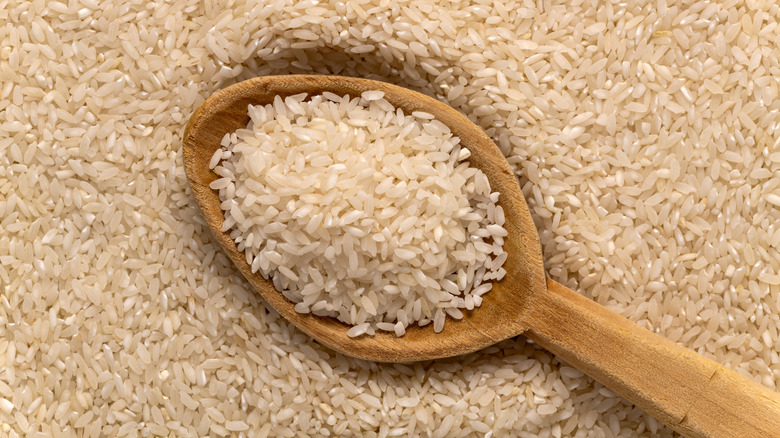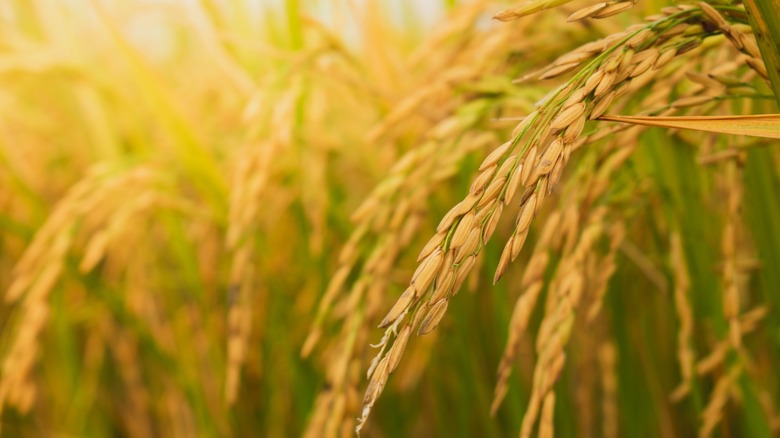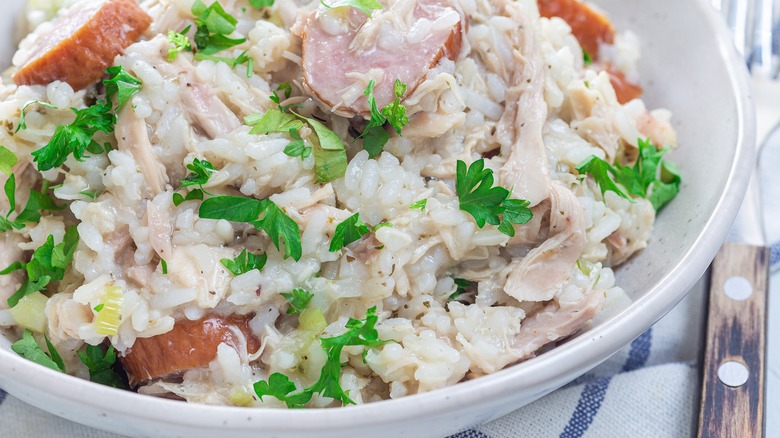The Origin Story Of Carolina Gold Rice Goes Way Back
Today, foods associated with the Southern U.S. have a reputation for being a bit on the heavy side — sumptuous, meaty, occasionally deep-fried. Think fried chicken, mac and cheese, shrimp and grits, barbecue. But one of the foundational elements of Southern cuisine is a much humbler ingredient: rice, which used to be grown all over the coastal Southeast, and which formed the backbone of the regional economy before the Civil War. It also formed the backbone of many a household menu in the same period. In parts of the South, there was a time when a meal wasn't a meal unless rice was involved.
This wasn't just any old rice, though. This was Carolina Gold rice, a distinctive variety — characterized by its firm texture and surprisingly nuanced rich and nutty flavors — that was grown by enslaved people in the mucky river swamps and tidal areas of the coastal Southeast. Are you a fan of Hoppin' John? (If not, here's a brief history.) This is the rice that the New Year's fave should be made with — and today, it's a special-occasion rice indeed. After falling out of production following the Civil War and being nearly forgotten during the 20th century, Carolina Gold rice has made a comeback in recent decades, thanks to devoted growers, agricultural scientists, and a fan base among prominent Southern chefs like Mashama Bailey, BJ Dennis, and Sean Brock. Both the fascinating history of Carolina Gold rice and its irresistible flavor make this grain well worth celebrating.
Where Carolina Gold rice comes from
Rice requires a lot of water to grow. This makes it well-suited to swampy areas like the Southeast, where it was a major crop in the antebellum era. Rice agriculture enriched plantation owners to an astronomical degree; around the time of the American Revolution, the Lowcountry region of Georgia and South Carolina was one of the wealthiest areas on the continent, if not the whole world. Of course, it wasn't the plantation owners doing all this work. Those whom they enslaved were sought out specifically from regions of West Africa — particularly the "Rice Coast," also known as the Windward Coast — where West Africans had developed deep expertise in this kind of agriculture.
By the start of the Civil War, most of the rice grown in the U.S. was South Carolina-produced Carolina Gold. But rice agriculture in the region soon declined due to the effects of the war and other factors like mechanization. The last commercial crop of Carolina Gold rice was harvested in 1927, and for most of the 20th century, it largely dropped out of sight. Until the 1980s, that is, when a Savannah ophthalmologist named Richard Schulze took an interest.
A duck hunter with a plantation on the other side of the Savannah River in South Carolina, Schulze was initially just looking to grow a food that would entice waterfowl. But, discovering Carolina Gold rice, he made it a passion project and brought the grain back into cultivation.
The resurgence of Carolina Gold rice (and what makes it special)
In 1986, Richard Schulze procured 14 pounds of Carolina Gold rice from a seed bank in Texas; two years later, he harvested 10,000 pounds of the stuff. Since he was an eye doctor, Schulze donated his yields to the Savannah Association for the Blind, which sold it to raise funds. But Schulze's activities prefigured a resurgence of interest in the rice. A decade after his first big harvest, another Carolina Gold enthusiast, Glenn Roberts, founded Anson Mills, a producer in Columbia, South Carolina that still sells Carolina Gold rice, along with other heirloom grains.
Other boutique rice growers have since joined Anson Mills, including Marsh Hen Mill and Rollen's Raw Grains, which both grow and sell Carolina Gold and other heirloom crops, like corn grits and red peas. They also sell middlins, which are rice grains that have broken into smaller pieces during processing; a favorite of chefs and diners, they're also sometimes called rice grits and can be cooked into a bowl of creamy goodness. As for Carolina Rice gold itself, it's especially suited to regional dishes like Hoppin' John, red rice (so central to South Carolina cuisine that, in 2018, the state designated an annual Red Rice Day), and bog, a stew of rice, chicken, and sausage. But Carolina Gold rice is so tasty that plenty of folks like to savor it just as it is with little more than a bit of butter and salt.


